Topic Tuesday #64 2013/10/08 - "Rose Colored Glasses & BS Detector Goggles"
I am, by nature, an inquisitive person. I do not take anything at face value. Everything needs to be respected enough to first give it some thought before drawing any conclusion. There are always shades of grey and multiple points of view. What these POVs have in common are facts. It's been said you are entitled to your own opinion, but not your own facts, and I adhere to that in my daily life. It is important to not get lulled into a false sense of reality, as many of the opinions you have were manipulated without your knowledge a long time ago (maybe generations in the past). This, at its core, is skepticism. Doubt. We have many built in tools for detecting fraudulent things. The ability to recognize deception is something we have honed over millennia. At the heart of the matter is a misinformation maelstrom; an arms race of lies. Better detection, better lies. Many concepts are so susceptible to deception that we think they are true, time and time again. The rose colored glasses of what we wish to be true, regardless of facts. And then... Conspiracy theories! Delicious tabloid lies!
We have many built in tools for detecting fraudulent things. The ability to recognize deception is something we have honed over millennia. At the heart of the matter is a misinformation maelstrom; an arms race of lies. Better detection, better lies. Many concepts are so susceptible to deception that we think they are true, time and time again. The rose colored glasses of what we wish to be true, regardless of facts. And then... Conspiracy theories! Delicious tabloid lies!I love a good conspiracy theory, as much as the next guy, and can certainly buy into them from time to time. It takes patient research to ferret the facts out of a "conspiracy" for one simple reason, most of the information is factual. The conspiracy just strings multiple facts together with leaps of logic that are just outlandish enough to be both interesting and possible, even if unlikely. The more grand and secret they are, the more they play on our psyche.
We have to bust out the BS Detector Goggles and put away the rose colored specs that make life just a beautiful and heart warming paradise. What we need are tools. Here is a list inspired and expanded from Carl Sagan's own "Baloney Detection Kit" born from "The Demon Haunted World".
* First, we have to have data. As much hard data as possible. Quantifiable facts are all you should be interested in until it is time to reason beyond them.
* Whenever possible there must be independent confirmation of the facts. Verification is important.
* Now, quickly you can apply Occam's Razor, and then Hitchen's Razor in turn.
Occam's Razor: "The simplest answer is often correct." (Very powerful tool.)
Hitchen's Razor: "What which can be asserted without evidence can be dismissed without evidence."
With the one/two punch of these epistemological razors, you can quickly cut to the heart of an issue.
* Brainstorm. Don't simply run with the first idea that caught your fancy; spin more than one hypothesis.
* Tear it apart by yourself. Try to defeat the hypothesis. Can you falsify the argument? Is it testable? Can/have others duplicated the experiment and the result?
* In testing the arguments hypothesis, did it rely on shaky information? You've heard it before (and with good reason), a chain (argument) is only as strong as its weakest link.
**When dealing with people, I highly recommend familiarizing yourself with "Logical Fallacies". We use them all the time in our speech and politicians pop them out every few words. I suggest taking a look at https://yourlogicalfallacyis.com/home and http://www.fallacyfiles.org/taxonomy.html but here are a few of the very popular:
* Begging the question (assuming an answer in the way the question is phrased).
* Ad hominem - attacking the arguer and not the argument.
* Straw man - caricaturing (or stereotyping) a position to make it easier to attack.
* Argument from "authority".
* Loaded Question - a question that couldn't be answered without appearing "guilty".
* Argument from adverse consequences (putting pressure on the decision maker by pointing out dire consequences of an "unfavourable" decision).
* Appeal to ignorance (absence of evidence is not evidence of absence).
* Confusion of correlation and causation.
* Post hoc, ergo propter hoc - "it happened after so it was caused by" - confusion of cause and effect.
* Meaningless question ("what happens when an irresistible force meets an immovable object?).
* Non sequitur - "it does not follow" - the logic falls down.
* Special pleading (typically referring to god's will).
* Observational selection (counting the hits and forgetting the misses).
* Statistics of small numbers (such as drawing conclusions from inadequate sample sizes).
* Misunderstanding the nature of statistics (President Eisenhower expressing astonishment and alarm on discovering that fully half of all Americans have below average intelligence!)
* Inconsistency (e.g. military expenditures based on worst case scenarios but scientific projections on environmental dangers thriftily ignored because they are not "proved").
* Suppressed evidence or half-truths.
* Excluded middle - considering only the two extremes in a range of possibilities (making the "other side" look worse than it really is).
* Short-term v. long-term - a subset of excluded middle ("why pursue fundamental science when we have so huge a budget deficit?").
* Slippery slope - a subset of excluded middle - unwarranted extrapolation of the effects (give an inch and they will take a mile).
* Weasel words - for example, use of euphemisms for war such as "police action" to get around limitations on Presidential powers. "An important art of politicians is to find new names for institutions which under old names have become odious to the public"
Now hopefully you have prepared your own kit and can interrogate the world for facts.
Don't let the skeptics of the skeptics get you down either. Just because you traded your rose colored lenses in for a magnifying glass and ask a lot of questions and seem rather contrary, doesn't mean that the reality we share has changed, or that something tastes different because you know more about it. What they will be unhappy with is not being able to get a fast one over on you any more.
I'm all out of gum, watch out for the weasel words!










